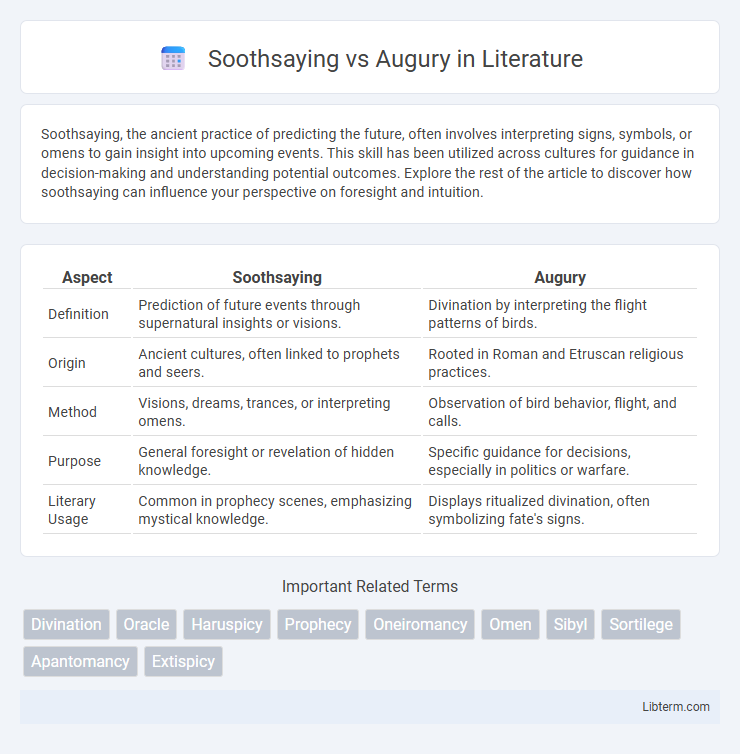Soothsaying, the ancient practice of predicting the future, often involves interpreting signs, symbols, or omens to gain insight into upcoming events. This skill has been utilized across cultures for guidance in decision-making and understanding potential outcomes. Explore the rest of the article to discover how soothsaying can influence your perspective on foresight and intuition.
Table of Comparison
| Aspect | Soothsaying | Augury |
|---|---|---|
| Definition | Prediction of future events through supernatural insights or visions. | Divination by interpreting the flight patterns of birds. |
| Origin | Ancient cultures, often linked to prophets and seers. | Rooted in Roman and Etruscan religious practices. |
| Method | Visions, dreams, trances, or interpreting omens. | Observation of bird behavior, flight, and calls. |
| Purpose | General foresight or revelation of hidden knowledge. | Specific guidance for decisions, especially in politics or warfare. |
| Literary Usage | Common in prophecy scenes, emphasizing mystical knowledge. | Displays ritualized divination, often symbolizing fate's signs. |
Introduction to Soothsaying and Augury
Soothsaying is the ancient practice of predicting future events through interpreting signs, visions, or omens, often involving supernatural insight or divination tools. Augury specifically refers to the Roman tradition of interpreting the will of the gods by observing the flight patterns and behaviors of birds, serving as a specialized subset of soothsaying. Both techniques have historically played crucial roles in decision-making processes across various cultures, blending ritualistic elements with early forms of prognostication.
Defining Soothsaying: Origins and Methods
Soothsaying, rooted in ancient cultures, involves predicting future events through supernatural insight or intuition, often relying on visions, dreams, or spiritual messages. Its origins trace back to early civilizations where seers or prophets interpreted divine signs to guide decisions and warn of impending occurrences. Methods include trance induction, crystal gazing, and oral prophecy, distinguishing it from augury, which specifically interprets bird behavior and omens.
Understanding Augury: History and Practice
Augury, rooted in ancient Roman religion, involves interpreting the will of the gods through the observed behavior of birds, specifically flight patterns and songs, to predict future events. This practice was a formalized, ritualistic process conducted by specially trained priests known as augurs, who played a crucial role in political and military decisions. Unlike general soothsaying, which may encompass various forms of divination, augury is distinct for its methodical observation of natural signs as divine messages within a structured religious framework.
Key Differences Between Soothsaying and Augury
Soothsaying involves predicting the future through supernatural insight, often using visions or prophetic dreams, while augury specifically interprets the will of the gods by observing the behavior of birds or other natural signs. Soothsayers typically rely on mystical or spiritual experiences, whereas augurs practice a formalized ritualistic method tied to religious traditions in ancient Rome. The key difference lies in soothsaying's broad divinatory approach compared to augury's focused use of specific omens and ritual practices.
Cultural Significance Across Civilizations
Soothsaying and augury hold deep cultural significance across civilizations, serving as tools for interpreting divine will and guiding decision-making. Soothsaying, practiced in ancient Mesopotamia and China, often involved prophecy through visions or dreams, reflecting spiritual and social beliefs. Augury, prominent in Roman and Etruscan societies, focused on observing birds and natural phenomena as omens, highlighting the connection between nature and religious authority in shaping political and military actions.
Tools and Symbols Used in Each Practice
Soothsaying relies on tools like tarot cards, crystal balls, and runes to interpret hidden knowledge through symbolic imagery and intuitive insight. Augury primarily involves observing natural signs such as the flight patterns of birds, animal entrails, and weather phenomena to predict future events. Both practices utilize distinct symbols--soothsaying leans towards man-made objects for divination, whereas augury depends on interpreting organic or environmental indicators.
Notable Practitioners Through History
Soothsaying, practiced by figures such as the Oracle of Delphi in ancient Greece, involved interpreting divine messages through visions and symbolic dreams, while augury, prominent in ancient Rome with practitioners called augurs, focused on reading the flight patterns and behaviors of birds to predict future events. Notable soothsayers included Tiresias, renowned in Greek mythology for his prophetic abilities, whereas Roman augurs like Titus Tatius played key roles in state rituals and decision-making. Both arts influenced political and religious life, with soothsayers often serving kings and augurs guiding magistrates during the Roman Republic.
Soothsaying and Augury in Mythology
Soothsaying and augury both hold prominent roles in mythology as methods of divination used to interpret the will of the gods and predict future events. Soothsaying typically involves prophetic revelations derived from visions, dreams, or direct communication with deities, often depicted in myths surrounding oracles like the Pythia of Delphi. Augury, rooted in ancient Roman mythology, specifically relies on interpreting the behavior of birds and other natural signs to gain divine insight, influencing decisions in warfare and statecraft.
Modern Perspectives and Relevance
Soothsaying and augury, ancient practices used to predict future events, hold different methodologies with soothsaying relying on interpreting dreams or visions, while augury traditionally involved observing birds' flight patterns. Modern perspectives treat both as cultural artifacts illustrating early human attempts to understand uncertainty and decision-making. Contemporary relevance stems from their influence on psychological and sociological studies, highlighting human cognitive biases and the need for ritualistic reassurance in uncertainty.
Conclusion: Interpreting Omens in the Present Day
Soothsaying and augury both involve interpreting signs to predict future events, but soothsaying relies on direct prophetic insight while augury interprets natural phenomena like bird flight patterns. Contemporary practices draw from these ancient methods to analyze symbolic data and forecast outcomes in decision-making processes. Understanding these differences enhances the accuracy of interpreting omens and integrating traditional wisdom into modern predictive frameworks.
Soothsaying Infographic

 libterm.com
libterm.com